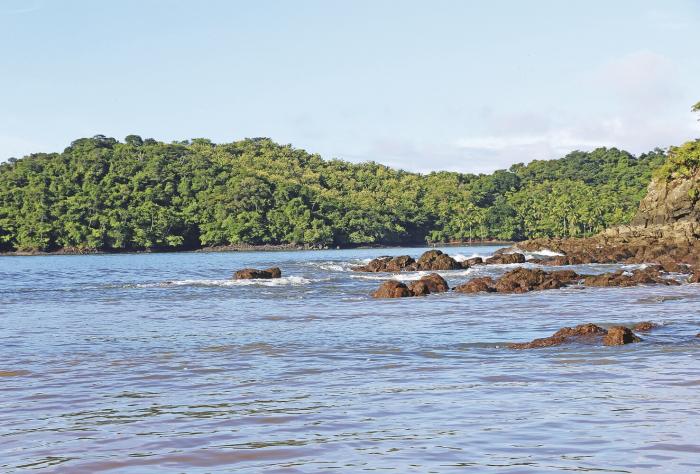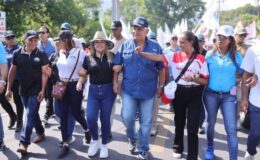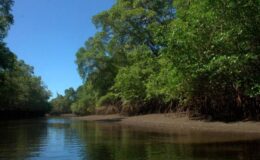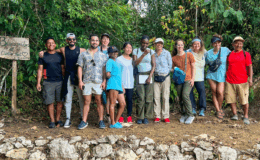Coiba AIP is a public interest association that conducts scientific research in the Coiba National Park. Edgardo Díaz Ferguson is the director of the organization and talks about the work he does and the plans to promote science in the country.

Coiba AIP is one of the five public interest associations that have been created in the country. Its office is in the City of Knowledge, but its operations center is about 300 kilometers away: on the island of Coiba, a nature reserve that has been a World Heritage Site since 2005.
The first marine ecology and biological oceanography laboratory was installed there in insular areas of the Central American Pacific to do, as its director Edgardo Díaz Ferguson says, “science”. Coiba AIP was created four years ago by the National Secretariat of Science and Technology (Senacyt) in order to promote, execute and develop scientific research aimed at protecting, conserving and maintaining the biodiversity of the Coiba National Park, its special marine area, its of buffer and the adjacent areas that are part of the Marine Corridor of the Eastern Tropical Pacific.
They are the general objectives that contain the specific ones, says Díaz Ferguson, a biologist with a doctorate in animal biology and genetics of marine organisms, and three post-doctorates, including those in genetics and environmental DNA of marine species, who after working and generating knowledge in other borders, he decided to return to Panama with the same purpose: to produce scientific knowledge for the development of the country, through Coiba AIP.
In these four years of operations, it has not only been dedicated to raising projects and carrying out scientific research, but also to recruiting Panamanian scientists who study or work abroad, to carry out studies in Coiba.

“The scientist is trained to generate research, knowledge, and that knowledge serves for the development of the country and not to write reports that end up shelved,” he claimed.
For Díaz Ferguson Coiba is a “living laboratory” because 12,000 years ago it was a “small mountain and a large plain” that linked Veraguas, and after the glaciation it became an island, and the fauna found in the area is very characteristic of her and, although they are probably the same mainland species, they may have different behavior and even morphology and phenotype.
Coiba AIP works in 14 areas of study and some are unprecedented in the country, such as underwater archaeology, for which Díaz Ferguson contacted the first Panamanian to complete a doctorate in this discipline: Abner Alberda, who studies at the University of Cadiz , Spain, and does his thesis in Coiba.
Alberda began his doctoral thesis at the same time that Coiba AIP was born and joined the project because archaeological prospecting has not been done in the area for many years, said Díaz Ferguson. It was agreed with the University of Cadiz that a scientist from Coiba AIP would be a thesis tutor and thus Ilian Izasa, a Panamanian doctor in archeology who lives in Boston, United States, joined the team.
In the search for Panamanian scientists outside the border, the Coiba AIP team contacted Orlando Ortiz, who lives in Germany and is studying for a doctorate in botany to carry out phylogeography on plants in the region. Díaz Ferguson indicated that evolutionary studies of plants associated with cloud forests and mountainous areas have not been carried out to determine how many exist in Panama.
To these scientific researchers abroad are added those who are in the country: Dumas Gálvez, who studies the spiders of the Coiba National Park; Eric Flores, who works on a sea turtle project; and Díaz Ferguson himself, who works on the characterization of the genetic biodiversity of marine invertebrate species and fish.
By the end of the year, Díaz Ferguson hopes to add two new scientists: an evolutionary biologist and a marine biologist. The idea of adding an evolutionary biologist, he explained, is to study the patterns in the terrestrial fauna of the Coiba National Park and determine how isolation from the mainland has generated new patterns of behavior and distribution of species.
Would the study determine if there are new species in Coiba?
It could be, but it is if the species that have been in the area have generated new aspects of behavior, physiology and reproduction different from those of the mainland, he indicated.
Díaz Ferguson explained that he has noticed behaviors of animals, such as the white-faced monkeys in Coiba, very different from those on the mainland. “These animals are not used to human presence, therefore they are not afraid of humans. In Coiba, the monkeys walk freely, and the howler monkeys usually come down from the trees, which is not normal, and that is a characteristic of an animal that has been isolated. They don’t see the human species as a predator,” he said.
The fact of coming down from the trees has allowed the monkeys to develop skills with both hands, such as the white-faced monkey that can lift a coconut from the front, break it and look for food, which is not observed in terrestrial populations, he explained.
Díaz Ferguson’s plans not only involve doing science, but also generating governance and interest among high school students to study science, specifically biology. Two fields in which he has begun to work to create spaces for dialogue between scientists and local authorities and the organization for the first time in Panama of the Latin American Congress of Marine Sciences to be held from September 19 to 23.
“In governance we are all equal, but if we scientists do not participate, we will not even be equal, they will not listen to us. So, we scientists have failed to believe ourselves superior and not descend into the world of mortals”, he acknowledged.
The idea is to sit down people of different thoughts to think about the country, for which it is looking for specialists in governance for the Coiba AIP team.
The Latin American Congress of Marine Sciences, explained Díaz Ferguson, is a window to publicize the work carried out by Coiba AIP, which is already recognized by the scientific world from Canada to Tierra del Fuego, Argentina.
The congress will be attended by some 400 scientists from 17 countries in the Americas, as well as Spain and Portugal, from the best research institutes and universities.
“We are living the decade of ocean science and we need students to be interested in studying marine biology, and Panamanian scientists who are abroad to return,” said Díaz Ferguson.
Public interest associations, such as Coiba AIP, are an opportunity to develop science and that Panamanian scientists abroad have the opportunity to generate knowledge.
“Science is the basis of society, it always has been. Without science we would not have medicines, bridges and a canal. Without science, we wouldn’t have conserved biodiversity either”, he stressed.
“Science is the basis of society, it always has been. Without science we would not have medicines, bridges and a canal. Without science we would not have conserved biodiversity either”

Díaz Ferguson insisted on the need to motivate young people to study marine science, because a developing country like Panama requires citizens in each of the lines of scientific research.
Panama can even be a leader in the region in scientific tourism, but for that, said Díaz Furguson, it is necessary to do science, and in Coiba, for at least four years, research has been carried out that not only contributes knowledge to the country, but to the world, because life comes from the sea.




No Comments